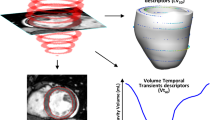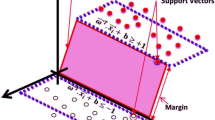Abstract
This paper presents a high precision and low computational complexity premature ventricular contraction (PVC) assessment method for the ECG human-machine interface device. The original signals are preprocessed by integrated filters. Then, R points and surrounding feature points are determined by corresponding detection algorithms. On this basis, a complex feature set and feature matrices are obtained according to the position feature points. Finally, an exponential Minkowski distance method is proposed for PVC recognition. Both public dataset and clinical experiments were utilized to verify the effectiveness and superiority of the proposed method. The results show that our R peak detection algorithm can substantially reduce the error rate, and obtained 98.97% accuracy for QRS complexes. Meanwhile, the accuracy of PVC recognition was 98.69% for the MIT-BIH database and 98.49% for clinical tests. Moreover, benefiting from the lightweight of our model, it can be easily applied to portable healthcare devices for human-computer interaction.












Similar content being viewed by others
References
Roth, G. A. et al., Global, Regional, and National Burden of Cardiovascular Diseases for 10 Causes, 1990 to 2015. J. Am. Coll. Cardiol. 70(1):1–25, 2017.
United Nations. Department of economic and social affairs population division. World Population Aging 2015. New York, 2015.
Chen, C. L., and Chuang, C. T., A QRS detection and R point recognition method for wearable single-lead ECG devices. Sensors (Switzerland) 17(9), 2017.
Yang, Z. et al., An IoT-cloud Based Wearable ECG Monitoring System for Smart Healthcare. J. Med. Syst. 40(12), 2016.
Pan, J., and Tompkins, W. J., A real-time QRS detection algorithm. IEEE Trans. Biomed. Eng. (3):230–236, 1985.
Friesen, G. M. et al., A Comparison of the Noise Sensitivity of Nine QRS Detection Algorithms. IEEE Trans. Biomed. Eng. 37, 1990.
So, H. H., and Chan, K. L., Development of QRS detection method for real-time ambulatory cardiac monitor. Annual International Conference of the IEEE Engineering in Medicine and Biology - Proceedings 1:289–292, 1997.
Zhou, F. Y., Jin, L. P., and Dong, J., Premature ventricular contraction detection combining deep neural networks and rules inference. Artif. Intell. Med. 79:42–51, 2017.
de Lannoy, G. et al., Weighted conditional random fields for supervised interpatient heartbeat classification. IEEE Trans. Biomed. Eng. 59(1):241–247, 2012.
Jung, Y., and Kim, H., Detection of PVC by using a wavelet-based statistical ECG monitoring procedure. Biomedical Signal Processing and Control 36:176–182, 2017.
Hao, H. et al., Multi-lead model-based ECG signal denoising by guided filter. Eng. Appl. Artif. Intell. 79:34–44, 2019.
Martis, R. J. et al., Computer aided diagnosis of atrial arrhythmia using dimensionality reduction methods on transform domain representation. Biomedical Signal Processing and Control 13(1):295–305, 2014.
Lu, W., Hou, H., and Chu, J., Feature fusion for imbalanced ECG data analysis. Biomedical Signal Processing and Control 41:152–160, 2018.
Utkarsh, J. et al., Classification of atrial arrhythmias using neural networks. IAES International Journal of Artificial Intelligence 7(2):90–94, 2018.
Christov, I. et al., Pseudo-real-time low-pass filter in ECG, self-adjustable to the frequency spectra of the waves. Med. Biol. Eng. Comput.:1–10, 2017.
Acharya, U. R. et al., Automated detection of arrhythmias using different intervals of tachycardia ECG segments with convolutional neural network. Inf. Sci. 405:81–90, 2017.
Acharya, U. R. et al., A deep convolutional neural network model to classify heartbeats. Comput. Biol. Med. 89:389–396, 2017.
Yildirim, O., A novel wavelet sequence based on deep bidirectional LSTM network model for ECG signal classification. Comput. Biol. Med. 96:189–202, 2018.
Mathews, S. M., Kambhamettu, C., and Barner, K. E., A novel application of deep learning for single-lead ECG classification. Comput. Biol. Med. 99:53–62, 2018.
Beach, C. et al., An Ultra Low Power Personalizable Wrist Worn ECG Monitor Integrated with IoT Infrastructure. IEEE Access 6:44010–44021, 2018.
ANSI/AAMI, Testing and reporting performance results of cardiac rhythm and ST segment measurement algorithms, Association for the Advancement of Medical Instrumentation (AAMI), 2008, American National Standards Institute, Inc. (ANSI), 2008 ANSI/AAMI/ISO EC57, 1998-(R).
Plesinger, F. et al., Parallel use of a convolutional neural network and bagged tree ensemble for the classification of Holter ECG. Physiol. Meas. 39(9), 2018.
Ott, G. et al., IIR Filter Architectures with Truncation Error Feedback for ECG Signal Processing. Circuits, Systems, and Signal Processing 38(1):329–355, 2019.
Subbiah, S. and S. Subramanian, Biomedical arrhythmia heart diseases classification based on aritificial neural network and machine learning approach. International Journal of Engineering and Technology (UAE), 2018. 7(3.27 Special Issue 27): p. 10–14.
Lee, R. G. et al., A novel QRS detection algorithm applied to the analysis for heart rate variability of patients with sleep apnea. Biomedical Engineering - Applications, Basis and Communications 17(5):258–262, 2005.
Chang, R. C.-H. et al., Design of a Low-Complexity Real-Time Arrhythmia Detection System. Journal of Signal Processing Systems:1–12, 2017.
Ramya, R., and Sasikala, T., An efficient Minkowski distance-based matching with Merkle hash tree authentication for biometric recognition in cloud computing. Soft. Comput., 2019.
Talbi, M. L., and Charef, A., PVC discrimination using the QRS power spectrum and self-organizing maps. Comput. Methods Prog. Biomed. 94(3):223–231, 2009.
Jewajinda, Y., and Chongstitvatana, P., A parallel genetic algorithm for adaptive hardware and its application to ECG signal classification. Neural Comput. & Applic. 22(7–8):1609–1626, 2013.
Chang, R. C. H. et al., High-Precision Real-Time Premature Ventricular Contraction (PVC) Detection System Based on Wavelet Transform. Journal of Signal Processing Systems 77(3):289–296, 2014.
Shi, H. et al., A hierarchical method based on weighted extreme gradient boosting in ECG heartbeat classification. Comput. Methods Prog. Biomed. 171:1–10, 2019.
Tekeste, T. et al., Ultra-Low Power QRS Detection and ECG Compression Architecture for IoT Healthcare Devices. IEEE Transactions on Circuits and Systems I: Regular Papers 66(2):669–679, 2019.
Almusallam, M., and Soudani, A., Embedded Solution for Atrial Fibrillation Detection Using Smart Wireless Body Sensors. IEEE Sensors J. 19(14):5740–5750, 2019.
Acknowledgements
Our research is supported by the National Key R&D Program of China (No. 2018YFB1307005).
Author information
Authors and Affiliations
Corresponding author
Ethics declarations
Conflict of interest
All authors declare that there is no conflict of interest in this work.
Ethical approval
All the procedures performed in studies involving human participants were in accordance with the ethical standards of the institutional and/or national research committee and the 1964 Helsinki declaration and its later amendments or comparable ethical standards. We have obtained the ethical approval for ECG data from Shanghai First People’s Hospital Affiliated to Shanghai Jiao Tong University, Shanghai, China.
Informed consent
Informed consent was obtained from all individual participants included in the study.
Additional information
Publisher’s Note
Springer Nature remains neutral with regard to jurisdictional claims in published maps and institutional affiliations.
This article is part of the Topical Collection on Mobile & Wireless Health
Rights and permissions
About this article
Cite this article
Wang, H., Shi, H., Chen, X. et al. A High Precision Real-time Premature Ventricular Contraction Assessment Method based on the Complex Feature Set. J Med Syst 44, 3 (2020). https://doi.org/10.1007/s10916-019-1443-x
Received:
Accepted:
Published:
DOI: https://doi.org/10.1007/s10916-019-1443-x




